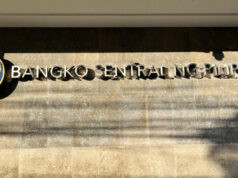ASEAN artists come together in a 3-part show
ON AUG. 8, 1967, the founding members of the Association of Southeast Asian Nations (ASEAN) — the Philippines, Malaysia, Indonesia, Singapore, and Thailand — signed a document (later known as the ASEAN Declaration) describing the region as “bound together by ties of history and culture.”
To conclude the commemoration of ASEAN’s 50th anniversary, the Philippines marks the occasion by hosting a contemporary art exhibit. Presented by the National Commission for Culture and the Arts (NCCA) through the Dalubhasaan Para sa Edukasyon ng Sining at Kultura (DESK) and with the support of the Office of Senator Loren Legarda, the exhibit, titled Ties of History: Art in Southeast Asia, features artworks by 10 artists — one from each ASEAN member state.
The exhibit is a “survey of contemporary art,” and “a diligent study of a particular practice” which allows the audience to look into the artists’ interests. The works are mounted in three major art institutions — the Metropolitan Museum of Manila, the University of the Philippines’ Vargas Museum, and the Yuchengco Museum in Makati.
The participating artists are: Amanda Heng (Singapore), Roberto Feleo (Philippines), Anusapati (Indonesia), Do Hoang Tuong (Vietnam), Chris Chong Chan Fui (Malaysia), Yasmin Jaidin (Brunei), Min Thein Sung (Myanmar), Vuth Lyno (Cambodia), Jedsada Tangtrakulwong (Thailand), and Savanhdary Vongpoothorn (Laos).
According to the exhibit curator Patrick D. Flores, the project began when NCCA Chairman and National Artist for Literature Virgilio Almario “found it important to commemorate” the 50th anniversary of ASEAN and wanted the exhibition to be spread throughout the metropolis.
“I thought of a curatorial process to involve three museums. I chose 10 artists to represent each ASEAN nation state, and each artist will showcase three types of work for each museum,” Mr. Flores told BusinessWorld shortly after the exhibit opening at the Yuchengco Museum on Aug. 9.
“As a curator, I wanted [to mount the exhibit] in different types of museums,” Mr. Flores said, noting that the Yuchengco museum is a corporate museum — most of the artists’ early works are on display there — while UP Vargas is a university museum and the experimental works and videos are on view there. The Metropolitan Museum, as a contemporary art museum, is where the installations are mounted. “Exhibitions are always site specific and [the] site also creates a dimension for the work,” he said.
THE ARTWORKS
The various early works of the participating artists at the Yuchengco Museum present their attitude on colonialism, nature, and personal experiences.
Representing the Philippines is sculptor and painter Roberto Feleo with his early works are from the sapin-sapin series of the 1970s and ’80s. “When I started painting, I had a problem of knowing what makes the work unique and what makes the work a signature piece,” he told BusinessWorld. Mr. Feleo’s research on Philippine representations in art made him use the layering of plywood. His other featured works in the exhibit include paintings inspired by the 1807 Basi Revolt in Ilocos Norte when Ilocanos fought against the Spaniards for prohibiting them from selling basi (sugarcane wine).
Thai artist Jedsada Tangtrakulwong’s Deserted Buildings (2008) features 23 manga comics with their contents cut out, leaving only the borders of the comic panels. “I remove all the character because when we look at the manga we always read for the story or content,” Mr. Tangtrakulwong said. Copies of the original manga are free for guests to go through and appreciate the material per se.
Myanmar’s Min Thein Sung worked in a large coffee shop after graduating from university. At the coffee shop, he found himself stressed and the schedule monotonous. He found respite in his visits to the restroom which inspired his 2008 work.
“One day, I realized when used the toilet that it just solving the problem of the physical. I was thinking, ‘Why did they give the restroom its name?’” Mr. Sung told BusinessWorld.
For his work titled Restroom, Mr. Sung made a toilet bowl from paper mache and travelled with it to various countries. Aside from the physical relief of the toilet, Mr. Sung thought of vacation as the relief for the mind. He then travelled with the paper mache toilet bowl and took pictures of it in isolated places, from beachfronts to meadows.
Amanda Heng of Singapore explores gender identity and her relationship with her mother in her work. Dear Mother (2009) shows a text installation and photograph of a woman’s chest with hands covering her breasts and another of a hand touching a woman’s back. “I wanted to express the relationship between my mother and myself but also mother and daughter relationship in general,” Ms. Heng told BusinessWorld.
CONTEMPORARY ART IN SEA
“Contemporary art in Southeast Asia is active and dynamic,” said Mr. Flores. “Before, the impression of art from Southeast Asia was traditional but its not the only kind of art that the Southeast Asia produces. Contemporary art is always in dialogue with tradition. It is also in dialogue with nature, the urban condition, and the changing phase of the countryside,” he noted.
“The Philippines is ready to host these kinds of exhibitions. In the past, the Philippines was only represented, but now we are able to host and invite [others] over here and give our own perspective,” he said.
The exhibition will be on view at the three museums until Oct. 6. — Michelle Anne P. Soliman



